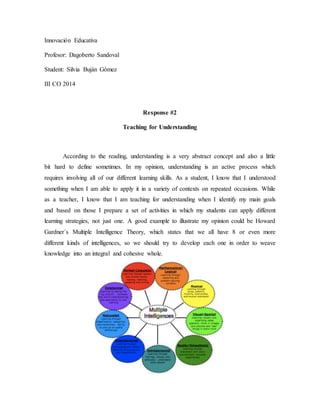Response 2
- 1. InnovaciÃģn Educativa Profesor: Dagoberto Sandoval Student: Silvia BujÃĄn GÃģmez III CO 2014 Response #2 Teaching for Understanding According to the reading, understanding is a very abstract concept and also a little bit hard to define sometimes. In my opinion, understanding is an active process which requires involving all of our different learning skills. As a student, I know that I understood something when I am able to apply it in a variety of contexts on repeated occasions. While as a teacher, I know that I am teaching for understanding when I identify my main goals and based on those I prepare a set of activities in which my students can apply different learning strategies, not just one. A good example to illustrate my opinion could be Howard GardnerÂīs Multiple Intelligence Theory, which states that we all have 8 or even more different kinds of intelligences, so we should try to develop each one in order to weave knowledge into an integral and cohesive whole.
- 2. Other good example could also be BrunerÂīs Theory of Discovery Learning which is basically learning by doing. His theory states that studentÂīs learning takes place in problem solving situation, in which they have to link their previous knowledge with the new input and make connections or discover the relationship between both. As a result, students may be more likely to remember concepts discovered by their own. After all, as Silvia Castro mentioned in the video, we only learn a 10% of what we read, 20% of what we hear, 30% of what we see, 50% of what we hear and see, 70% of what we say, and a 90% of what we do. 10% reading 20% audio 30% visual 50% audio-visual 70% discuss 90% performed Finally, something that I found very interesting not only from the reading, but also from the video was that our brain is very flexible, so as bigger the stimulus bigger the connections we make inside our brain, and therefore, more significant the learning process.


